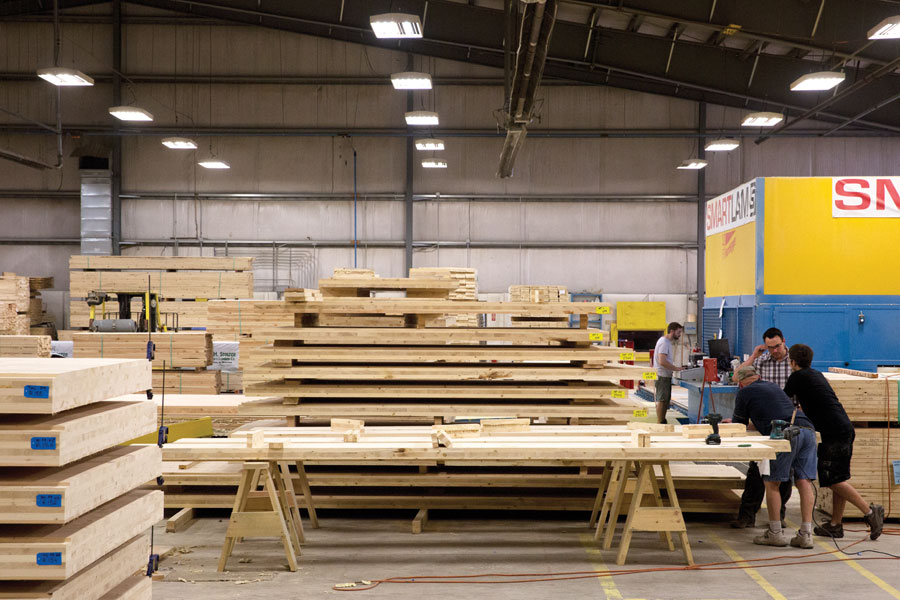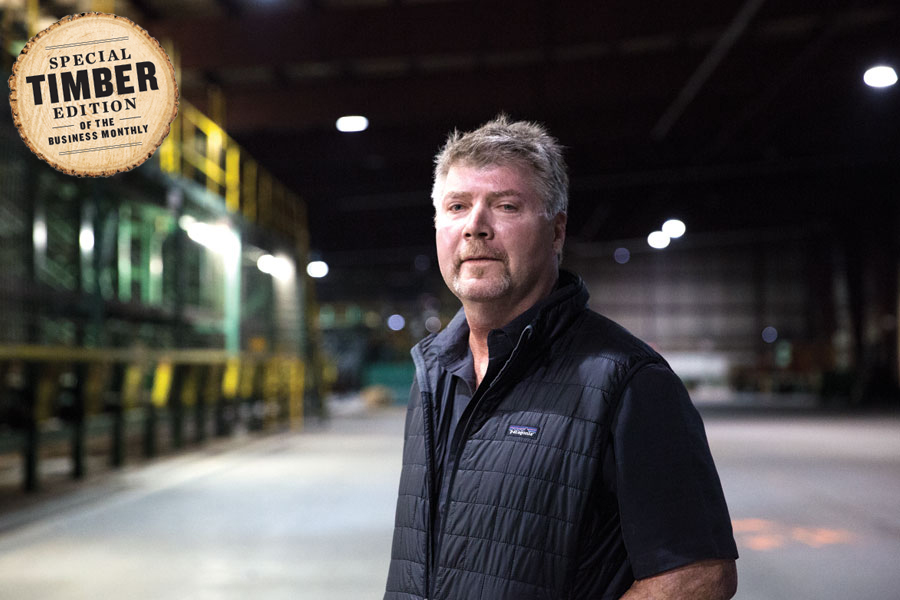COLUMBIA FALLS — The shuttered lumber mill on the northern edge of town, once brimming with activity and helping power the local economy and the region’s mighty wood products industry, sits in silent abandonment. Dust and pigeon sign occupy the sprawling facility that stretches more than 3 acres and is mostly shrouded in darkness from fading light bulbs. It once illuminated the historic heart of a timber empire but now represents a bitter reminder of a diminished dynasty.
Casey Malmquist sees a brighter future. The revival is underway.
Malmquist, president and general manager of SmartLam Technologies Group, is preparing to relocate and expand his wood products company at the former lumber mill site.
SmartLam, a rapidly growing local manufacturer of cross-laminated timber, or CLT, will expand from its 40,000-square-foot facility behind Western Building Center to the 140,000 square-foot lumber mill building formerly owned by Plum Creek Timber Co. and then Weyerhaeuser Co.
Roughly $15 million worth of new “state-of-the-art” equipment will be installed in the facility as SmartLam takes a quantum leap in production, quadrupling from 20,000 cubic meters annually to more than 80,000. After completing the relocation, estimated by the end of 2019, SmartLam will be one of the largest CLT manufacturing operations in the world.
At its new headquarters facility, the company will triple its staffing, from 35 employees to more than 100 by the end of 2019, adding a wide variety of high-paying skilled positions, including designers, engineers, operators and other specialists, Malmquist said.
The solidification of SmartLam’s headquarters in Columbia Falls is poised to ripple beyond town and greatly benefit the regional suppliers — loggers historically situated within roughly 200 miles of the Flathead Valley — that provide SmartLam with the spruce, pine and fir used to make CLT, which consists of custom-cut wood panels stacked in alternating directions and bonded with adhesive.
Two additional satellite plants are also poised to open in the coming years, one in Maine and another in the Southeast, as SmartLam branches out as a national supplier of what is being described as the next big thing in the timber industry.
“This could really be the start of something big,” Todd Morgan, director of forest industry research at the University of Montana’s Bureau of Business and Economic Research, said.
“It is definitely good news for lumber producers in Montana, especially in (the Flathead Valley)… It’s a pretty positive development. This is where high tech meets wood products.”

In the beginning, wood was the original building material. The evolution of engineered wood products traces back centuries, and signs of laminated wood were discovered in the tombs of the Egyptian pharaohs and in the remnants of former Chinese dynasties.
The first patent for what would become plywood emerged in the 1860s, but the three-ply product didn’t spark considerable interest in the building industry until 1905, when a manufacturing company in Portland, Oregon, debuted its new-age product at the World’s Fair. Pretty soon plywood was a household building material used in everything from doors to vehicle running boards. By 1929, there were 17 plywood mills in the Pacific Northwest. Plum Creek broke ground on its plywood plant near its headquarters in Columbia Falls in 1964 and soon became a regional player in the lucrative market.
With innovations such as plywood, the wood products industry thrived through much of the 20th century. In 1977, Plum Creek employed over 1,000 people in Western Montana, including 632 in Columbia Falls. Concrete and steel took over as the primary building materials for large-scale developments, but lumber remained the top material for single-family homes.
Over the last few decades, due to a variety of factors, including market forces and automation, the nation’s timber industry experienced significant downsizing. By late August of 2016, the final logs rolled through the Weyerhaeuser Company’s plywood plant and lumber mill in Columbia Falls, signaling the latest closure in a languishing wood products industry. Montana has seen 30 mills close in the last 25 years.
Washington-based Weyerhaeuser, which merged with Plum Creek in 2016, shuttered operations at the two Columbia Falls sites as well as at the nearby administrative building, cutting nearly 200 jobs in the process. The adjacent medium-density fiberboard plant continues to operate, as does the mill in Evergreen.
Yet an unlikely resurrection is occurring with SmartLam’s meteoric rise.
The exciting development dates back six years. Malmquist, who moved to Whitefish in 1993 and re-established his homebuilding business, Malmquist Construction, was working in the Bakken in the midst of the Great Recession. He was contracted to build housing units for the deluge of workers in the oil fields. There was a group from Whitefish that introduced Malmquist to this new type of building material that had emerged in Europe in the 1990s and was taking off in Canada. It was called cross-laminated timber.
“For me it was one of those snap-to moments,” Malmquist said. “To me it was an absolute no-brainer, so I got very interested very quickly.”
The benefits stretched wide and far: CLT was quick to install and could be just as sturdy as its heavy-duty counterparts. It also didn’t pose the same negative environmental effects that are associated with steel and concrete.
“I have two personal missions and visions with this,” Malmquist said. “One is on the environmental side. Any time we can replace concrete and steel, it’s making a positive impact on global climate change. How many times do you get an opportunity in your life to make that kind of impact? The other one is locally, creating an opportunity for high-quality jobs for people here in the Flathead.”
In 2012, Malmquist co-founded SmartLam with three parties, including John Lesar and Western Building Center, in a warehouse attached to WBC in Columbia Falls. The company became the nation’s first commercial manufacturer of CLT. At first, SmartLam created planks for drilling access sites, but in the years since it has taken an evolutionary step into the commercial and residential markets, using Malmquist’s background as a builder.
“That happened quicker than we were anticipating because of the collapse of the oil market, but in hindsight it was a blessing in disguise,” Malmquist said.
The production of CLT has the potential to create significant job growth across the Pacific Northwest, according to a study published this summer in Oregon. The Pacific Northwest is home to several shuttered timber mills, and, “Rebuilding this industry will help stem the tide of displaced workers leaving the community, provide skilled jobs in advanced manufacturing and construction, and rebuild local economic development capacity,” according to the report by an Oregon organization that partnered with the Department of Commerce and local economic development authority to study the feasibility of CLT’s rise.
“Over the years, typically, when a new engineered wood product came along it replaced an old product. But this is brand new,” Craig Rawlings, president and CEO of the Forest Business Network, said.
“(CLT) is a game changer. There are lots of great engineered wood products, but they are primarily used for single-family housing. Now this has evolved into commercial buildings as well. This is a great innovation that will help our overall industry.”

The Oregon report determined that CLT and similar engineered wood products have the potential to create 2,000 to 6,100 direct jobs in Oregon alone. Labor income generated from direct jobs in mass timber manufacturing would range from $124 to $371 million a year, the report said. Labor income from total impacts would be between $338 million and $1 billion annually.
Oregon has indeed jumped on the CLT bandwagon first in terms of adopting regulations and building codes that open the door for mainstream use. This summer, SmartLam hosted a conference showcasing Oregon officials, including the mayor of Springfield, who talked about the benefits of using renewable, sustainable engineered wood for large-scale projects. Among other projects, a 90,000-square-foot building complex, stretching 12 stories into the sky, is emerging in downtown Portland as the nation’s first high-rise structure made almost entirely out of wood.
“Oregon’s forests are a tried and true resource that may again be the key to economic stability for rural Oregon, expanding opportunity for communities hit hard by the decline of the natural resource economy,” Oregon Gov. Kate Brown said in a statement after the building broke ground in June. “The (high-rise) building shows that we can use sustainably harvested timber in a sustainable way to act as a catalyst for economic development through the creation of timber and manufacturing jobs in rural economies.”
Malmquist sees structures like that and others as signs of the future, and signs of SmartLam’s potential.
A year ago, the local company reached a sizable milestone by receiving certification for its engineered wood products from the American National Standards Institute, the leading organization that sets health and safety standards for business products and services in the U.S. This opens it up to national opportunities, and SmartLam is capitalizing. The company is currently developing complicated projects that show the variety of CLT uses: a military housing facility in Washington; an eight-story building in Seattle; a bus transit center in North Carolina.
“The interest in quantity and quality has grown exponentially,” Malmquist said.
What makes SmartLam unique is that it doesn’t simply make and ship its products to a builder. It offers designers and engineers who work with the customer to create each custom build. With more than 30 years in the building industry, Malmquist is expertly suited to meet the needs that come with building a large-scale commercial site.
The new property is attached to the railroad, which will help SmartLam ship a larger amount of CLT across the country, addressing the challenge of transportation. There’s also the room to grow and address the spike in demand.
“Being the mover in the U.S., we want to keep that position through innovation, through focusing on the service side of this and the quality of our manufacturing,” he said.
Looking at the dim, empty lumber mill site in Columbia Falls, Malmquist sees a brightening future. SmartLam will occupy roughly 10 acres of the property, and the other 30 acres, owned by an investment group called Columbia Rising, is well suited for additional manufacturers.
“This is all pretty exciting,” he said.
“This is an opportunity for some world-class employment opportunities right here in Columbia Falls, Montana.”
